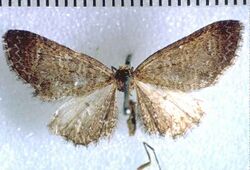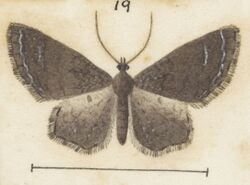Biology:Pasiphila acompsa
| Pasiphila acompsa | |
|---|---|

| |
| Male holotype | |
| Scientific classification | |
| Domain: | Eukaryota |
| Kingdom: | Animalia |
| Phylum: | Arthropoda |
| Class: | Insecta |
| Order: | Lepidoptera |
| Family: | Geometridae |
| Genus: | Pasiphila |
| Species: | P. acompsa
|
| Binomial name | |
| Pasiphila acompsa (Prout, 1927)[1]
| |
| Synonyms[2] | |
| |
Pasiphila acompsa is a moth in the family Geometridae. It was described by Louis Beethoven Prout in 1927.[2] It is endemic to New Zealand and has been observed in mountainous locations in both the North and South Islands.[3] Larvae of this species have been reared on plants within the Veronica genus. Adults are on the wing from December to February.
Taxonomy
This species was first described by Alfred Philpott in 1915 and named Chloroclystis modesta.[4] However the species name Chloroclystis acompsa was proposed by Louis Beethoven Prout as a replace name for the name given by Alfred Philpott which Prout regarded as being preoccupied by Chloroclystis modesta described by William Warren.[5][2] In 1971 John S. Dugdale placed this species in the genus Pasiphila.[6] In 1988 John S. Dugdale discussed this species under the name Pasiphila acompsa and in 2010 Robert Hoare in the New Zealand Inventory of Biodiversity followed this placement.[2][3] The male holotype specimen was collected at Bold Peak in the Otago by Charles Cuthbert Fenwick and is now held at Te Papa.[2]
Description
Philpott's description of this species is as follows:
♂♀ 26–29 mm. Head, thorax, and abdomen dark brownish-fuscous, sparsely mixed with grey. Palpi reddish-tinged, 2 1⁄2. Antennae in ♂ ciliate-fasciculate, ciliations 4 1⁄2. Forewings rather narrow, costa subsinuate, slightly arched, termen sinuate on lower half, moderately oblique; fuscous-brown; markings obscure, grey-whitish; veins interruptedly marked with blackish; many irregularly serrate or waved transverse striae; a more distinct pair at 1⁄3, and 3 or 4 similar ones defining outer edge of median band at 2⁄3; an obscure blackish discal dot; a faintly greenish-tinged serrate subterminal line: cilia fuscous with paler median line, sometimes indistinctly barred with darker. Hindwings, termen irregularly rounded, prominent at veins 3 and 4; fuscous-grey, darker dorsally; a dark discal dot; some lighter striae obscurely indicated on dorsum: cilia as in forewings. Differs from Chloroclystis halianthes Meyr. in the irregular termen of the hindwings. It is also much darker in colour, and the cilia are not distinctly barred.[4]
This species is similar in appearance to Pasiphila dryas but it lacks the pink-brown shade of the latter species.[7]
Distribution
This species is endemic to New Zealand and has been observed on Mount Taranaki and Mount Ruapehu in the North Island and on Ben Lomond, Bold Peak and around Lake Wakatipu, all in Otago in the South Island.[7] P. acompsa has been observed at altitudes of between 3,000 and 4,000 feet.[7]
Behaviour
Adults of this species are on the wing from December to February.[7]
Hosts
Larvae of this species have been reared on plants within the Veronica genus.[8][9]
References
| Wikimedia Commons has media related to Pasiphila acompsa. |
- ↑ "Pasiphila acompsa (Prout, 1927)". Landcare Research New Zealand Ltd. http://www.nzor.org.nz/names/182f8b9d-d3a6-480c-b7aa-dceb75217682. Retrieved 14 May 2018.
- ↑ 2.0 2.1 2.2 2.3 2.4 , pp. 188, Wikidata Q45083134
- ↑ 3.0 3.1 , p. 460, Wikidata Q45922947
- ↑ 4.0 4.1 , pp. 193, Wikidata Q66084596
- ↑ , pp. 76, Wikidata Q110670763
- ↑ , pp. 106, Wikidata Q64006453
- ↑ 7.0 7.1 7.2 7.3 , pp. 94, Wikidata Q58593286
- ↑ "Pasiphila acompsa (Prout, 1927) Herbivore Report". https://plant-synz.landcareresearch.co.nz/ReportForm.aspx?RecordId=1557&Type=H&ReportType=Adv&SortBy=Alpha&Biostatus=a,c,e,n.
- ↑ , Wikidata Q107569572
Wikidata ☰ Q13879051 entry
 |



